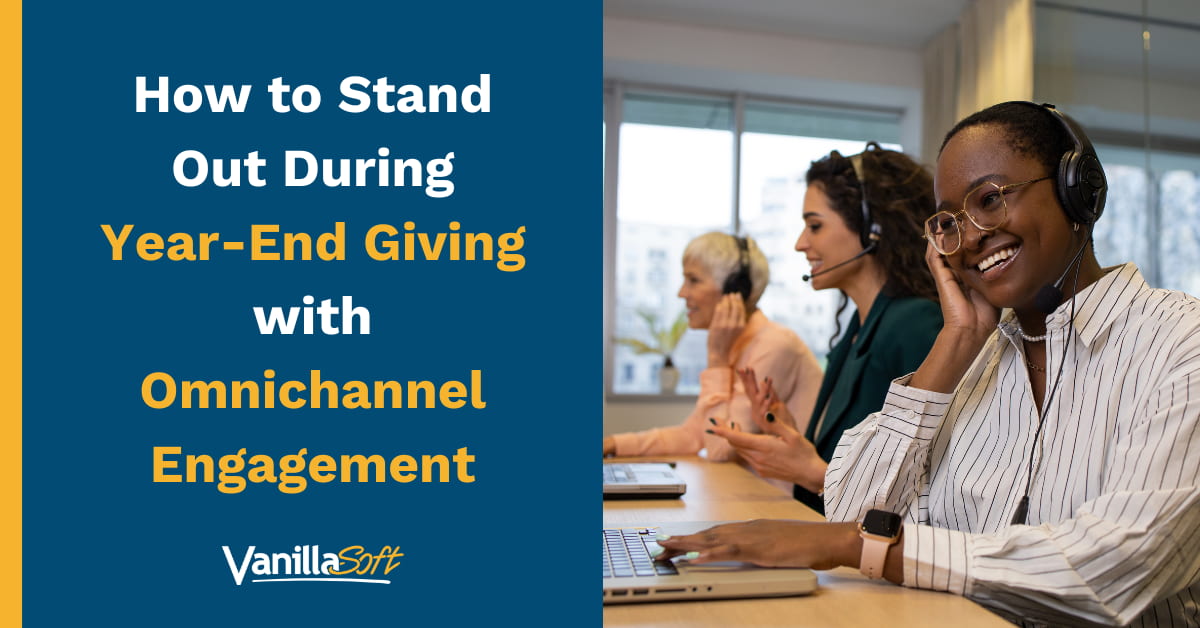
The year-end giving season is a time of immense generosity; a period where individuals and communities rally together to support the causes closest to their hearts.
But today’s donors, particularly those contributing to universities and colleges, are more discerning than ever. There are numerous causes and initiatives fighting for their attention. Donors seek deeper connections, personalized experiences, and tangible evidence of their impact. Their priorities have shifted beyond simply writing a check. They want to be active participants in the institutions they support – engaging across various platforms and seeking a consistent, meaningful experience.
This shift requires a new approach to donor engagement that acknowledges the multifaceted nature of modern philanthropy. Enter omnichannel engagement — a strategic and integrated approach that orchestrates a harmonious donor journey across all touchpoints.
Why Omnichannel Engagement Is Essential for Year-End Giving
Think about your own experiences as a consumer. You likely interact with your favorite brands through their website, social media, email newsletters, and maybe even text messages. You expect a consistent and personalized experience no matter how you choose to engage.
The same applies to donors.
They expect to be engaged across various channels — email, social media, text messages, phone, and even video. Omnichannel engagement allows you to meet those expectations and tailor your communication to each donor’s preferences, making them feel valued and understood. This personalized approach leads to increased engagement and a higher likelihood of donors taking action, which is particularly important for cutting through the noise of the numerous fundraising initiatives that take place during year-end giving campaigns.
What Are the Benefits of Omnichannel Engagement?
Enhanced donor experience
We’ve already established that the modern donor interacts with universities through a multitude of channels — websites, social media, email, events, and more. However, omnichannel engagement goes beyond simply being present on these channels. To be effective, this approach should focus on ensuring a coordinated and consistent experience across all of them.
The omnichannel approach ensures a seamless and unified donor-centric experience across a variety of touchpoints.
Imagine a prospective donor exploring your university’s website, then receiving a personalized email invitation to a virtual campus tour, followed by targeted social media ads showcasing student success stories.
This cohesive journey makes donors feel truly valued and creates a sense of belonging to the university community. By breaking down communication silos and delivering a consistent brand experience, you create a positive and engaging journey that encourages continued interaction and support.
Personalized engagement
Generic mass emails are no longer enough. Your donors expect communication that is tailored to their individual interests and preferences.
Omnichannel allows you to leverage data and analytics to segment your audience and personalize your outreach.
For example, a recent graduate might receive emails about young alumni events and career services, while a loyal donor might be invited to exclusive lectures and research presentations.
This personalized approach not only enhances the donor experience but also creates a deeper connection with your institution. When your donors feel understood and appreciated, they’re more likely to stay engaged and continue supporting your mission.
Similarly, omnichannel facilitates ongoing communication and personalized follow-up, which are essential for building lasting relationships with donors. This long-term perspective is crucial for securing major gifts, planned giving, and endowment support.
This is where having a robust donor engagement platform like VanillaSoft can be invaluable. VanillaSoft allows you to track donor interactions across all channels, segment your audience based on their preferences and behaviors, and automate personalized communications.
VanillaSoft houses all your donor data in one place so that your student fundraisers can easily access what they need to keep the conversations going. The talk track feature takes traditional scripts to the next level and makes it easier for your team to stay on message and confidently guide conversations toward successful outcomes.
Strengthened brand identity
Maintaining a consistent brand identity across all communication channels is vital for building trust and credibility. This consistency exudes a sense of professionalism and reliability, making donors more confident in their decision to support your institution.
Omnichannel ensures that your institution’s values, mission, and visual identity are consistently reflected in every interaction with donors. Whether it’s your website, social media posts, email newsletters, or event materials, a unified brand experience reinforces your message and strengthens your reputation.
Strategies for Successful Omnichannel Engagement
To effectively implement omnichannel engagement and reap its many benefits, universities need a strategic and well-coordinated approach.
Know your audience
Developing a deep understanding of your alumni and donor base is the foundation of any successful omnichannel engagement strategy. We’re not talking about basic demographics, but about delving into their giving history, interests, communication preferences, and engagement patterns.
Leverage data and analytics to segment your audience into meaningful groups, allowing you to tailor your communication and create more personalized experiences.
For example, you might segment your audience based on graduation year, giving level, areas of interest (e.g., scholarships, research, athletics), or preferred communication channels.
Such a granular understanding of your audience empowers you to deliver the right message to the right people at the right time.
Craft personalized journeys
Once you have a clear understanding of your audience segments, you can begin crafting personalized communication journeys that resonate with each group.
These journeys should be tailored to their specific interests, preferences, and giving history.
Let’s say a potential donor is a history enthusiast who is passionate about preserving historical archives. When they visit your website, they should be able to easily find information about your university’s history department, special collections library, and any ongoing research or projects related to historical preservation.
To further personalize the experience, you might send this donor targeted emails about upcoming lectures or events related to history, invite them to exclusive tours of the archives, or even offer a personalized phone call to discuss their interests and how they can support the history department.
Optimize your digital presence
Your website is often the first point of contact for potential donors. Ensure that your website is mobile-responsive, easy to navigate, and features compelling stories about the impact of philanthropy.
Use high-quality visuals, impactful storytelling, and clear calls to action to engage visitors and encourage them to learn more about your institution and its mission.
Your social media channels are another vital part of your online presence. They offer a unique opportunity to connect with your audience in a more informal and engaging way. Use these platforms to share a glimpse into campus life. Keep your audience informed about research breakthroughs and the importance of supporting these initiatives. And don’t forget to share stories and testimonials that illustrate how donor contributions are making a difference in the lives of students, faculty, and the broader community.
The main goal is to create a consistent brand experience across all your digital platforms, ensuring that your messaging, visuals, and tone of voice are aligned.
Diversify your communication channels
Donors interact with your institution through a variety of channels, so it’s essential to diversify your communication strategy.
Utilize a mix of email, social media, text messaging, video, and even direct mail to connect with donors in meaningful ways. Tailor your message and channel to the specific audience segment and communication objective.
For example, you might use email for regular newsletters, event invitations, and impact reports. Social media can be used for sharing timely updates, engaging with followers, and promoting events. Text messaging can be effective for delivering urgent appeals, event reminders, and campaign updates.
Finally, direct mail lends itself perfectly to personalized thank-you notes, impact reports, and major gift solicitations.You can also leverage donor cadences to stay top of mind with your supporters without overwhelming them and causing donor fatigue.
In Conclusion
The year-end giving season is a critical time for universities to connect with donors and inspire support. By embracing omnichannel engagement, you can create personalized and meaningful donor experiences that encourage lasting relationships and drive philanthropic success. Remember, today’s donors expect more than just a generic ask. They want to be seen, heard, and valued. Omnichannel engagement provides the framework to deliver exactly that.



